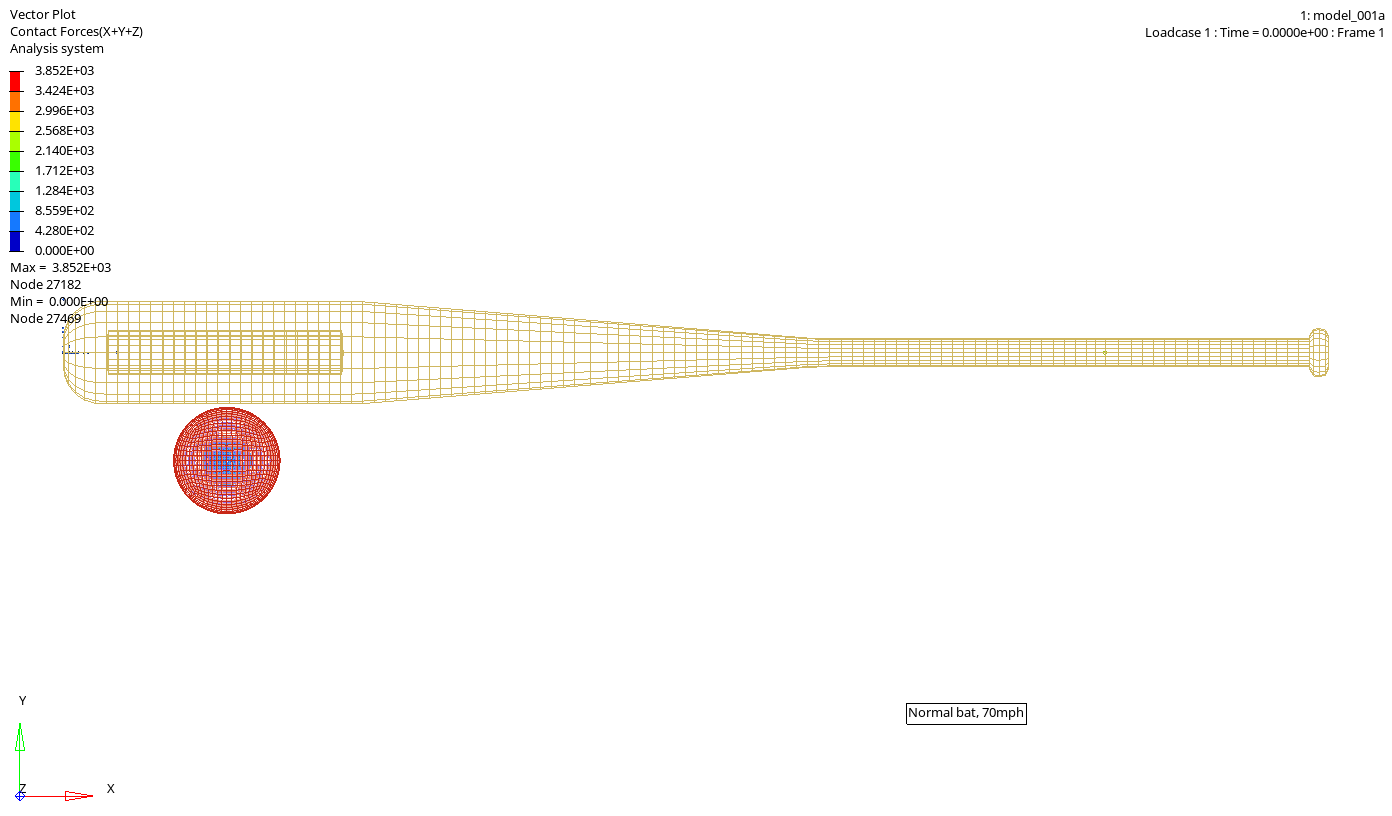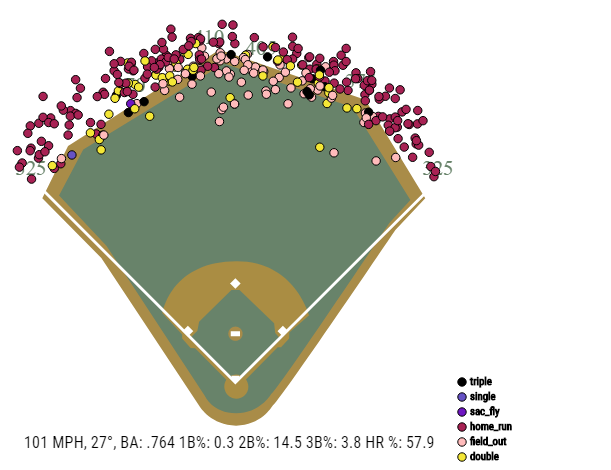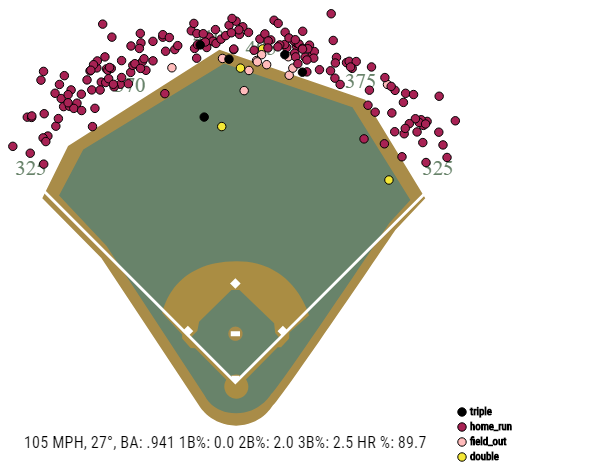Digital Debunking: Baseball’s Great Corked Bat Debate
Does using an illegal corked bat really improve your chances of hitting a home run?
This post was written by Will Haines, Eric Nelson, and Dmitri Fokin
This week’s Major League Baseball All-Star Game and Home Run Derby will showcase baseball’s biggest and brightest stars. Seeing hitters launch baseballs unfathomable distances into the bleachers got us thinking, are there ways hitters could gain an edge over the competition? What if we could simulate just how much of an effect this would have on their performance?
In 1994, Albert Belle of the Cleveland Indians was one of the biggest power hitters in baseball. But he was hiding an illicit secret to his success. Before a July game in Chicago against the White Sox, the opposing manager was tipped off that Belle may
have been using an illegal corked bat. Umpires confiscated the bat and locked it in their dressing room.
Knowing the bat would soon be tested and his cheating discovered, Belle’s teammate Jason Grimsley crawled through an overhead crawl
space connecting the visitor’s locker room to the locked umpire dressing room, lowered himself down through a displaced ceiling tile, and switched Belle’s bat with a legal bat. Evidence of this caper was quickly discovered. The new bat
had the signature of teammate Paul Sorrento on it, two ceiling tiles were askew overhead, and the floor was littered with clumps of ceiling insulation. Albert Belle was suspended for 10 games, and the corked bat heist went down as one of the most
colorful stories in baseball cheating history.
Since the beginning of the sport, baseball players have been looking for every competitive advantage to enhance their performance. One of the oldest, and most debated, practices in baseball’s rich history of cheating is the “corked”
bat. Major league bats are typically made of solid wood from maple or ash trees. A corked bat is an illegal modification made by drilling a hole in the bat’s barrel and filling it with lighter, less dense material like cork. This lighter bat
is thought to allow the hitter to swing the bat faster while improving the hitter’s timing and possibly even creating a spring effect to improve power.
With our modern understanding of physics and advanced simulation technology, we wanted to put the corked bat theory to the test. Does a modified cork bat really help batters hit more home runs? We used nonlinear finite element analysis technology to find out.
Boundary Conditions
In the first simulation experiment, we compared the performance of a solid wood bat made of ash wood to a bat with a cork insertion using the same swing and pitch speed conditions. we used a rotational speed of 52.17 radian per second (rad/s) to correspond to a 70-mph bat velocity, roughly the average swing speed of a major league hitter.

Boundary conditions set on the bat for initial rotation around a pivot point and initial velocity
The initial velocity of the ball was set to 40.23 meters per second, equivalent to a 90 miles per hour pitch. The baseball weighs 141.7 grams and is comprised of white cotton, grey woolen yarn, white woolen yarn, red rubber, black rubber and a cork core. All of these are viscous hyperelastic materials (Ogden material law).

Cross-section of baseball simulation model
The lighter cork material made the corked bat 72 grams lighter than the solid wood bat, but otherwise, all other variables are constant in the two simulations.
Experiment 1: Comparison of Solid and Corked Bats Swung at the Same Speed
The simulated maximal contact force of the solid ash bat was 38.415 Kilonewtons (KN) and 38.734 KN for the corked bat. The ball’s final velocity hit with the legal bat was 100.66 mph, and baseball velocity hit with the lighter illegal bat was 102.89 mph, a difference of about 2.2%. It’s clear from this first simulation that a corked bat would perform slightly better than a solid wood bat swung at the same speed. However, with the corked bat’s lighter weight, it stands to reason that a batter could swing the illegal bat faster. How much more could this increased swing speed tilt the performance of the corked bat? Further experimentation was needed.

Simulation variant 1: Normal bat swung at 70mph

Simulation results from variant 1
Experiment 2: Comparison of Solid and Corked Bats with Higher Corked Bat Swing Speed
With the same pitch speed conditions, we wanted to account for this potential increase in swing speed with a corked bat. In our second experiment, we simulated the difference in force transfer and ball exit velocity between a solid wood bat swung at 70 miles per hour and a corked bat swung at 73 miles per hour (an educated guess of the increased rotational acceleration offered by the reduced bat mass). Setting the corked bat’s rotational speed at 54.36 rad/s, we tested this against the same solid wood bat swung at 52.17 rad/s from experiment 1.


Comparison of impact between normal bat, corked bat, and corked bat swung at faster speed
By applying increased bat rotational speed, we observed a significant increase in contact force and ball exit velocity. It seems that the loss of mass in the illegal bat was more than offset by the hitter’s ability to swing the bat at much greater
force. The final baseball velocity off the corked bat was 4.3% greater than the solid ash bat.
The next step was to determine how much this difference in exit velocity would affect the hitter’s probability of hitting a home run.
The most common launch angle for home runs in the major leagues is between 25 and 30 degrees. We used a tool from Major League Baseball’s website to plot the probability of a home run between our solid wood bat and corked bat swing at the higher
rate of speed. The Statcast Exit Velocity & Launch Angle Field Breakdown tool produced the following results.

Outcome probability of 101mph ball velocity at 27-degree launch angle Source:
https://baseballsavant.mlb.com/statcast_field © MLB Advanced Media, LP. All rights reserved.

Outcome probability of 105mph ball velocity at 27-degree launch angle Source:
https://baseballsavant.mlb.com/statcast_field © MLB Advanced Media, LP. All rights reserved.
A ball hit with an exit velocity of 101 mph at a 27-degree launch angle would have a 57.9% chance of being a home run. A ball hit at 105 mph on the same launch angle would make the odds of a home run a staggering 89.7%.
Additional factors such as backspin of the ball, weather conditions, stadium dimensions and elevation could also be factored in, but generally, the results of our simulation allow us to conclude that the added exit velocity produced by the added swing speed of the corked bat has a significant effect on home run probability.
Although Albert Belle was ultimately punished for his corked bat, it seems that the science backs up his use of this illegal technique. Cheaters never win in the end, but based on this simulation, you might be able to hit a couple extra dingers before you get caught.

All simulation for this blog was done using Altair RadiossTM, a leading structural analysis solver for highly non-linear problems under dynamic loading. Learn more about Altair Radioss here: https://altairhyperworks.com/product/RADIOSS
Thanks for continuing to follow our Digital Debunking series. We are having a ton of fun researching and writing these blogs. If you have an idea for what we could debunk
next, leave a comment below. It could be one of our next features!
Sources:
- Albert Belle story:
- Experiment inputs
- https://www.postandcourier.com/sports/dangerous-trend-in-baseball-as-pitching-speeds-increase-so-do/article_22670354-b5cf-11e8-934a-3b63e3a10c4b.html
- https://entertainment.howstuffworks.com/corked-bat-hit-ball-farther1.htm
- https://www.uml.edu/docs/Thesis-Andrew%20Sutton-2010_tcm18-60869.pdf
- https://medium.com/joeblogs/fun-with-statcast-exit-velo-20e4ec314744
- Home run probability:




